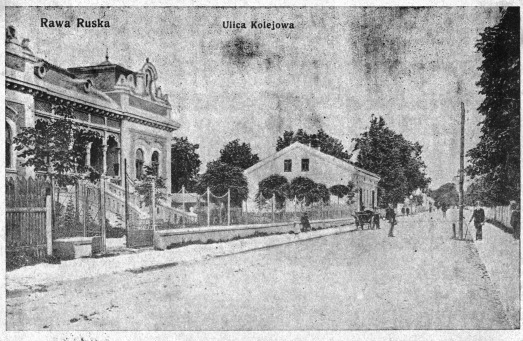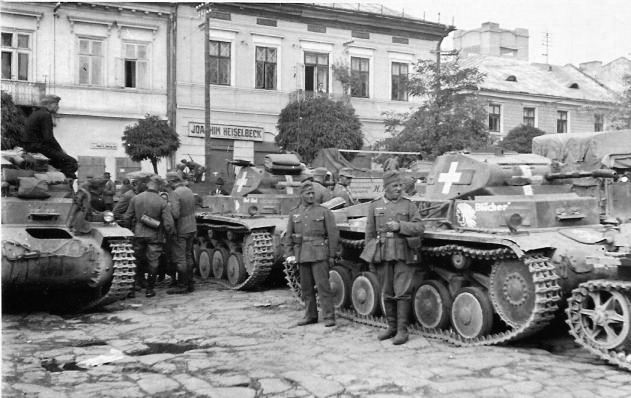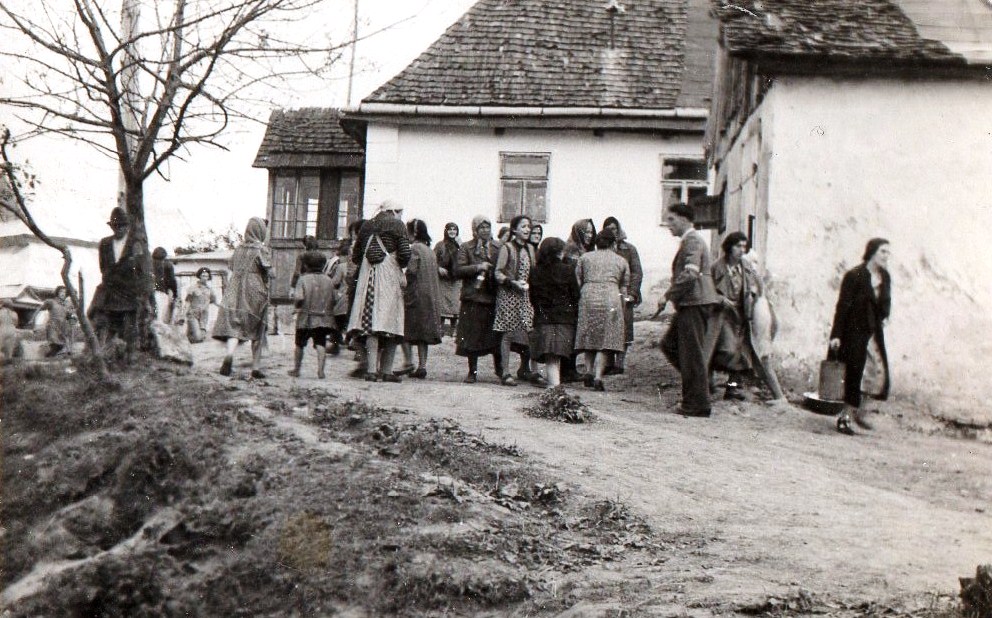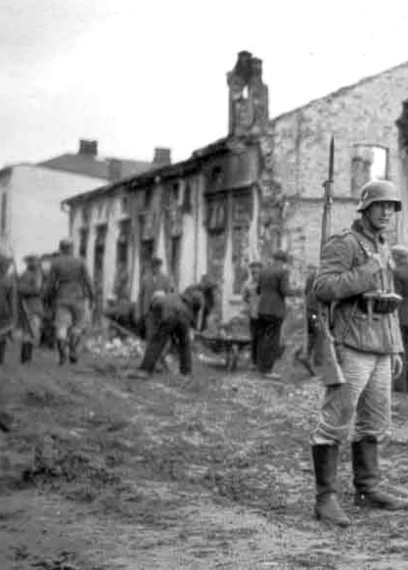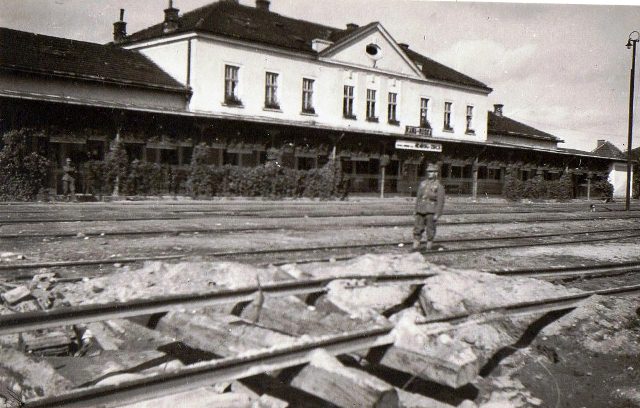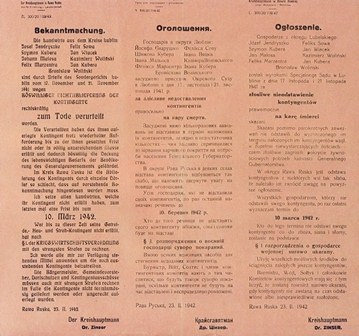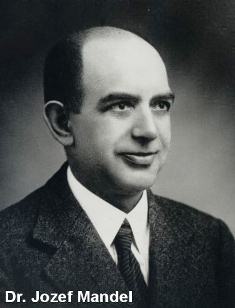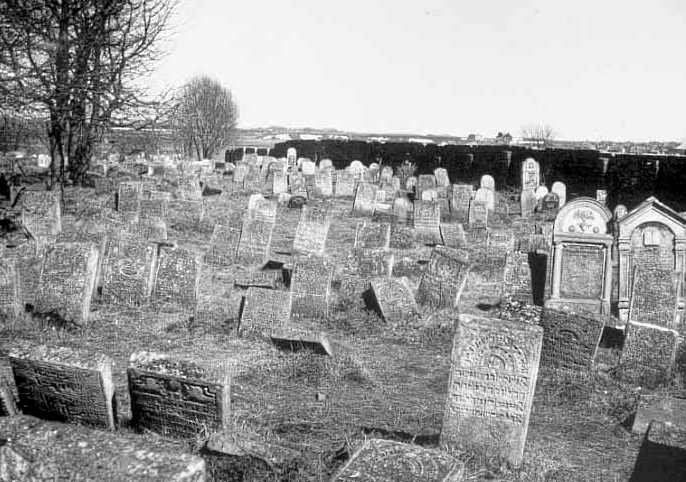Holocaust Education & Archive Research Team |
Ghettos Introduction to the Ghettos of the Holocaust
Jewish Ghettos The Judenrat Judenrat Leaders Prominent Jews
| ||||||||
Rawa Ruska
Rawa Ruska is located in the Lwow distrit, formerly it was part of Poland, but today it is part of the Ukraine. The first Jews arrived with the founding of the town in 1624, in the 18th Century they were subjected to restrictions and to heavy taxes under the Austrians from 1772.
The town developed as a stop-over on the Lwow – Warsaw railway line, the Jewish population increased from 3,878 to 6,112 in 1910, Jewish trade centred on egg marketing abroad, but they were also prominent as furriers and hat -makers, a Jewish stoneware factory declined with the advent of porcelain utensils.In 1884 a fire destroyed 234 Jewish homes and a Baron Hirsch school was founded in 1892, reaching an enrolment of 200 within six years, following the First World War was reduced by about 1,000.
Devastating fires struck the community again in 1923 and 1932, during the inter-war years the Jewish fur trade developed considerably with markets throughout Poland. The Soviet annexation of Poland which lasted from September 1939 to June 1941curtailed Jewish communal and commercial life, with the German invasion of Russia, the Germans captured the town on the 28 June 1941.
As a foretaste of things to come the local Ukrainian militia immediately executed 100 Jews and the Germans instituted a regime of forced labour and extortion. A Judenrat was established in July 1941 and in the spring of 1942 they were concentrated into a crowded ghetto area.
Shortly thereafter Rawa Ruska, as the county town, was incorporated into the Generalgouvernement, within the Distrikt Galizien, under the control of SS-Brigadefuhrer Dr Wachter. At the beginning of the German occupation there were no anti-Jewish measures in the town, however in the surrounding smaller towns such as Niemirow, Magierow, Sokal and Kulikov, German soldiers together with Ukrainian nationalists organised anti-Jewish pogroms.
As part of increasing anti-Jewish restrictions the Jews were forced to wear armbands marked with the Star of David, premises were marked with a Jewish Star of David and used by the Germans to perform forced labour.
In mid-July 1941 a Jewish Council known as a Judenrat was established with Wastenberg as the President. During this time there was no closed ghetto in Rawa Ruska, Jews were allowed to live anywhere in the town, as they could before the occupation, there were no Gestapo or SD premises in Rawa Ruska but a Krimminalpolizei (KRIPO) office was there. In August 1941 the Germans demanded monetary contributions from the Jews of Rawa Ruska, the advocate Dr Jozef Mandel opposed the Germans’ orders and refused to give them the Jews for forced labour and the money they demanded.
Members of the German Security Services (SD) from Sokal arrived in Rawa Ruska and arrested 15 members of the Jewish intelligentsia, as well as Dr Mandel. He was taken out of the town at night, as the Germans were concerned that the population might resist. As a hostage Dr Mandel was taken to Krakow where he was incarcerated in the notorious Montelupich prison, his niece Erna Weinberger, nee Hartel from Gorlice sent him a food parcel in August 1941. Dr Mandel died in Montelupich Prison from typhus circa December 1941.
The first “aktion” in Rawa Ruska was organised at the end of March 1942, which saw the arrival of SD men from Sokal who combined with Ukrainian police, armed with lists, arrested about 1,000 Jews who were gathered in the square outside the Kripo office in the centre of the town. The “aktion” was conducted without brutality, the arrested people – mainly elderly men and women had no idea what was happening and where they were being taken. They were led to the railway station and loaded onto a waiting train, 100 Jews in every cattle car all of them were deported to the newly established death camp at Belzec.
From the beginning of 1942 the Jews in Rawa Ruska heard rumours about the construction of a camp in Belzec, but nobody knew of the true nature of this establishment. During the first days after the first mass deportation the Jews were unaware of the fate of the deportees, but a few days afterwards an elderly woman who had hidden in a latrine on the camp grounds escaped and returned to the town and informed the local population of the fate and that Belzec meant death. The next “aktion” took place on the 27 July 1942, when SD men from Sokal, just as before, arrived in Rawa Ruska. Panic spread throughout the town, many Jews tried to hide.
For the first time the Germans forced the Jewish Police to take part in the deportation “aktion,” units were organised so that one SD man, one Ukrainian policeman and one Jewish policeman had to control the searches on a single street. People were taken from their houses and hiding places, this time there were no selections and about 2,000 people were arrested, and unlike the first “aktion” which had been conducted quite peacefully, the Jews were beaten at the assembly place and on the way to the Rawa Ruska railway station. The destination was the same as the first transport, the death camp at Belzec.
By that time the Jews in Rawa Ruska knew everything about the death camp, they knew there were gas chambers and that thousands of Jews had already been murdered there. “Everybody knew but nobody spoke about it. We knew that nobody spoke about it. We knew that nobody returned from there,” wrote Wolf Sambol, one of the few survivors from Rawa Ruska.
Rawa Ruska was the main railway junction through which the trains to Belzec ran, every day Jews working at the railway station observed the transports containing Jews deported from other towns. They heard the screams of people who pleaded for water. On a number of occasions the transports halted at the railway station in Rawa Ruska and although the local Jews knew about the fate that probably awaited the deportees, they did not want to tell them the truth. In many trains the deportees already knew about Belzec and they jumped out of the transports. The German or Ukrainian guards killed most of them, but overall about ten percent of the “jumpers” survived and sought refuge in Rawa Ruska. The witness Wolf Sambol wrote;
“These newcomers from the trains were called “jumpers” by us. Every day the Jews from Rawa gathered the bodies of killed “jumpers” which were transported in horse wagons to the Jewish cemetery. Here they were buried in mass graves. The German authorities did not know about the “jumpers” in our town. The Jewish inhabitants hid them in cellars. We estimated there were about 2,000 “jumpers” in Rawa.
Several weeks after the second “aktion” the Germans issued an order for the establishment of a closed ghetto in Rawa Ruska, the Jews were concentrated in the three streets, in the poorest part of the town, on the right side of the market square. In September 1942, Jews from the surrounding towns and villages of Lubycza Krolewska, Uhonow, Potylicz, Magierow and Niemirow were also sent to the ghetto in Rawa Ruska, and by the end of September 1942 there were about 15,000 people in the ghetto, including a large number of “jumpers.”The Jews in these overcrowded three streets lived in unbearable conditions, 20 -30 people lived together in one room, there were only two wells for the entire population, with no electricity, incarcerated behind barbed wire.
It is therefore came as no surprise within a short space of time a typhus epidemic broke out, and as a consequence the Germans organised the next “aktion” which became known as the “aktion against the sick people.” SS –Hauptscharfuhrer Josef Grzimek born in Ober Glogau, who saw service in the Lemberg (Lvov) Janowska prison and in Plaszow – Krakau concentration camp organised this “aktion.” He ordered the Judenrat to organise a larger unit of Jewish police – shortly before this “aktion” there were a total of 50 Jewish policemen in Rawa Ruska. On the 7 December 1942 the SS men, Ukrainian and Jewish policemen started to search every house in the ghetto.Many people tried to hide sick members of their families, as special bunkers had been built in most houses. In numerous cases people passively awaited their fate in their rooms. The Germans and Ukrainians shot many Jews on the spot – in their houses, even in their beds.
During the four days of the “aktion” the Jews were gathered in the buildings of the synagogue and in several wooden sheds, from these locations they were sent to the Rawa Ruska railway station and from there deported to Belzec where they all perished. In the square between the synagogue and the Beth Midrash drunken German and Ukrainian policemen shot many people, approximately 6,000 – 7,000 Jews were deported to the death camp. It is not known how many Jews were killed in the ghetto. The December 1942 deportations from Rawa Ruska were probably the last transports that were sent to the Belzec death camp.
During the December “aktion” the SS men and members of the Kripo department from Rawa Ruska, namely Spatt, Klein, Tragner and Meiert organised selections. Young men and women fit to work were selected and sent to a number of small work camps near Rawa Ruska at Kamionka and Rata. A substantial number of these Jews selected in the December 1942 “aktion” were also sent to the notorious Janowska camp in Lvov. A sizeable number of Jews was left in Rawa Ruska and they were employed at cleaning the vacated Jewish houses in the ghetto, a smaller group of Jews called the “Death Brigade” was selected from the larger group.
Their work consisted of gathering the bodies of those killed during the “aktion,” the bodies were buried in a mass grave at the Jewish cemetery. When they finished their gruesome task, Grzimek gathered them together in one house in the ghetto and setting the building ablaze, burned them alive.
At the beginning of March 1943 there were officially only 100 Jews left in the ghetto but there were more people in hiding places within many of the houses. It has been estimated that there was perhaps a total of 350 – 400 Jews in the ghetto. SS-Hauptsturmfuhrer Pressmann who, according to survivors was more “human,” replaced Josef Grzimek, he lived in a house in the ghetto area and never personally killed any Jews, but the Kripo members continued hunting the “illegal Jews” living in hiding in the ghetto. A Jewish underground was established in the ghetto, the Jewish partisan commander Auersbach made contact with Soviet partisans near Rawa Ruska and obtained weapons from local peasants. The Jewish partisans prepared to fight in the event of the Germans finally liquidating the ghetto.
However, this potential act of resistance never occurred, since some partisans decided to escape from the ghetto, when they were at the Catholic cemetery a peasant denounced them to the Germans. The Germans killed all the Jews at there. Before his death, one of the Jews told the Germans about the entire partisan organisation, the German policemen arrested Auersbach and executed him. The final liquidation of the ghetto took place on the 8 June 1943, before the “aktion” the Germans organised another piece of deception. They ordered the gathering of a “contribution” of 100,000 zlotys as a surety for the survival of the ghetto inmates.
The Germans claimed that all the Jews of Rawa Ruska would be sent to the work camps in Potylicz and Rata, this included the “legal” and “illegal” Jews, the ghetto inhabitants believed the Germans and paid the “contribution.” When the money had been collected, all the people were gathered together but instead of transfer to the work camps they were taken to the forest at Borove and executed.
Only a few Jews from Rawa Ruska survived those who had escaped from the ghetto prior to the “aktions,” local Poles in Rawa Ruska hid some of them, one of them Bazyli Chmielewski who rescued two Jewish families, some nine people, constructed one of the biggest shelters in Rawa Ruska. After the Second World War Bazyli Chmielewski lived in Lublin and was decorated by Yad Vashem, he died in Lublin in 2004, almost 90 years old.The territory of the ghetto in Rawa Ruska was totally destroyed,all of the houses were burned and today stands unsightly Soviet-style blocks of apartments. The Jewish cemetery was demolished too and only a few tombstones can still be seen and no memorials have been built to remember this once vibrant Jewish community.
Gregory Havan aged seventy-six, Borove Lwow region, was interviewed by Father Patrick Debois on the 25 April 2004
Patrick Debois; Do you remember when the Germans arrived in Rawa- Ruska?
Gregory Havan; Yes, the first time they came was in September 1939, then again in 1941.
PD; What happened?
GH; The war had been going on for two weeks in The Jews were frightened they didn’t go to see them but went to hide. The soldiers didn’t shoot but gave the children sweets – though instead of giving them to us in our hands they threw them on the ground. They stayed two weeks. After that, they knew they would have to give up territory, they brought us things, we were poor at the time. A soldier told us that they wouldn’t stay long, that they would leave again for the west and that the Russians would soon arrive.
PD; How did they create the ghetto?
GH; On June 22 1941, the war began and planes started bombing us. The border was only 15 kilometres away. Shooting began. Wounded Russians were brought in on wooden stretchers.
Then the Germans arrived, we didn’t have a kolkhoze here, so the Germans came and asked all the farm owners to give a bag of 100 kilos of potatoes. I remembered I helped my father put the potatoes in a bag. They were for the Jews in the ghetto of Rawa-Ruska, it was all they would have to eat during the whole event. They had ordered all the Jews in the village to wear an armband on their right arm with the Star of David. The cloth was white and the star black. The Jews had to give up the milk from their cows. Then they were taken to Rawa. There they were shot; there was a cremation oven. The Jews were frightened, the Jews of our village, including one of my colleagues, were all taken.
PD; What were they made to do?
GH; I’ll tell you what I remember. In Rawa the Jews lived all over the town, in every street. There wasn’t a Jewish neighbourhood. Then it was decreed they should all live together and that they shouldn’t live with Catholics. They were all told to gather in the middle of the town, all crowded in together.
PD; What happened to the empty houses?
GH; They made a ghetto on a single street, where no one was allowed to enter. We weren’t allowed to bring things in but we did it anyway. Jews gave us money for a chicken or something else. They began by shooting old people and children, they left people between the ages of 18 and 45 to make them work. Three kilometres away, they killed them, people fell like flies. I didn’t see them but I heard the shots. I saw a young Jew who brought corpses in a cart to the Jewish cemetery. It was during the winter of 1942, there was blood and the ground was red.
PD; Why did they choose Borove as the location to shoot the Jews?
GH; I don’t know. In June 1943, a German officer came with a dog, to visit the village then left after a quarter of an hour. The following morning, very early, perhaps at 6 or 7 o’clock, the Jewish police with a tractor and a truck Then perhaps one or two hours later, trucks full of people arrived, people were sitting in the trucks, they were accompanied by Ukrainian and Jewish police. They had brought the people to this place. The people were sitting in the truck and the police were guarding them with rifles. I remember that a girl tried to escape by jumping from the truck, she was shot in the forest.
PD; How were the Jews shot?
GH: I don’t know, we weren’t allowed to go there. I know that the trucks arrived one after the other. Afterwards there were shots.
PD; But afterwards, did they requisition people to bury them?
GH; The Jews dug the pits themselves. We went there the next day and the pits were covered with a thin layer of earth. I don’t know if the Germans did that themselves. Very soon afterwards, blood began running from the pit.
Towards 5 or 6 in the evening, we began to smell an odour and then, as it smelled of death, they forced people who had carts and horses to bring sand there. They also put chlorine, that allowed them to lower the level of the pit by one meter, and the blood stopped running.
PD; After that, did the Germans continue guarding the place?
GH; No, everyone could go there. Because the Jews had undressed there and people saw the Germans taking the civilian clothes of women and men, they came to see if they could find something; money, rings, gold watches….
From time to time the policemen threw them a coat, and they found things – they even found American dollars. The Jews had hidden all these things in the ground. After that people didn’t go there anymore and a forest began to grow in the place that used to be a field.
PD; Did people come to say Jewish prayers there?
GH; When the Russians arrived, there were no more than five Jews, who left after the war. No one came to say a prayer. People came to see the pit, and they walked around the area, but that’s all. Sources: Encyclopedia of The Holocaust – published by Macmillan Publishing Company New York 1990 The Holocaust by Bullets: A Priest’s Journey to Uncover the Truth Behind the Murder of 1.5 million Jews, by Father PatrIck Desbois, published by Palgrave Macmillan 2009 T he Destruction of the European Jews by Raul Hilberg, published by Holmes and Meier 1985 The Holocaust – The Jewish Tragedy by Sir Martin Gilbert – published by William Collins Sons and Co Ltd, London 1986 The War against the Jews by Lucy S Dawidowicz – published by Bantam Books 1979 Transcripts of the IMT at Nuremburg – Avalon Project at Yale Law School.Holocaust Historical Society Photos: Private Collection Holocaust Historical Society
Copyright Chris Webb and Chip Sother. H.E.A.R.T 2011
|
